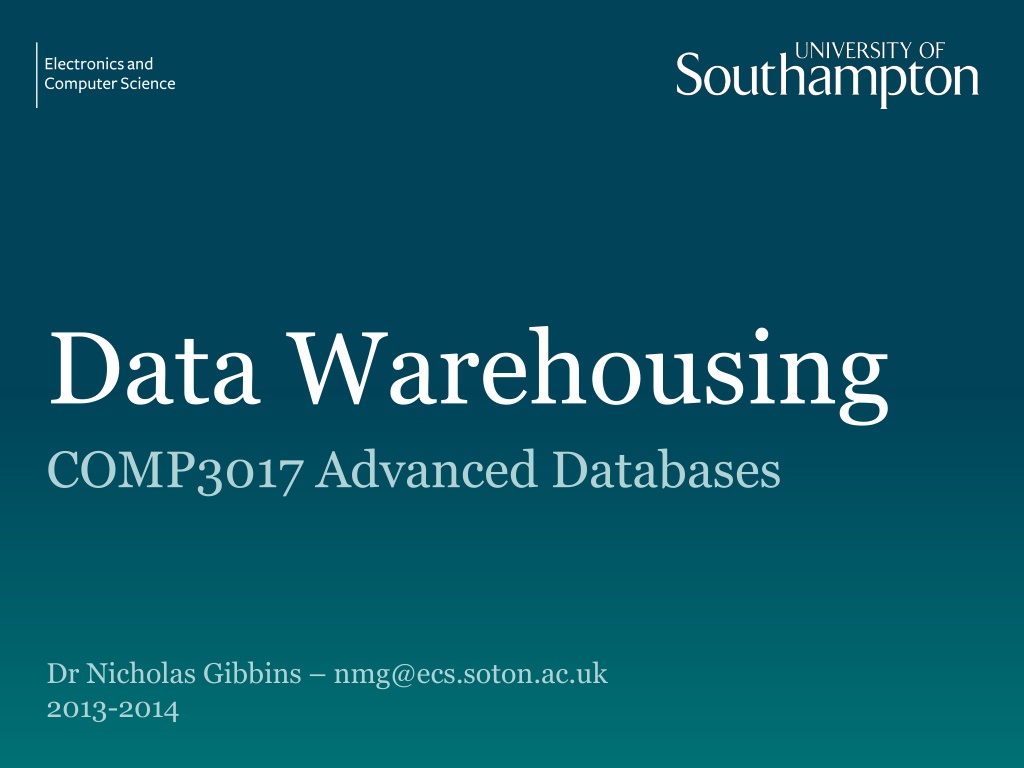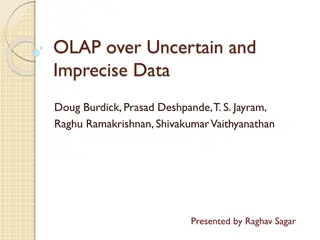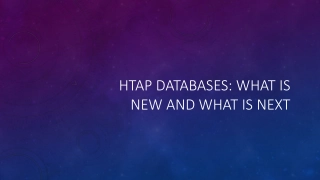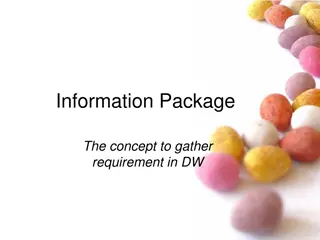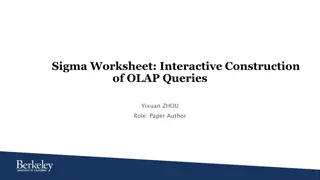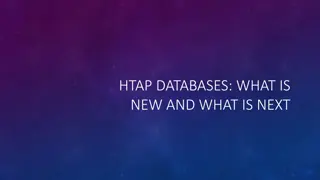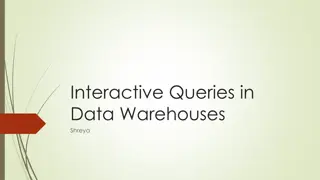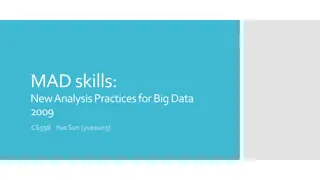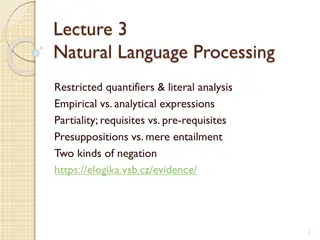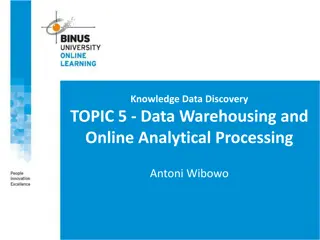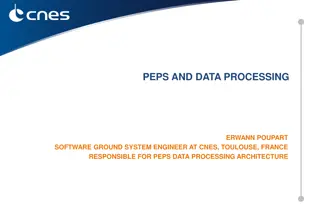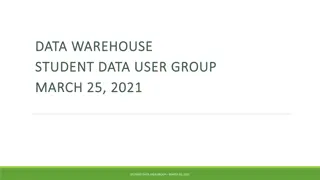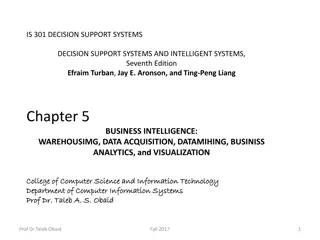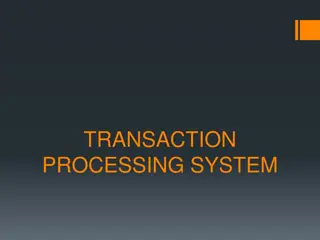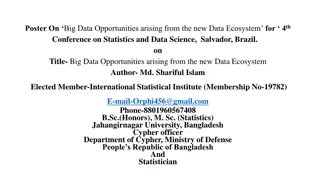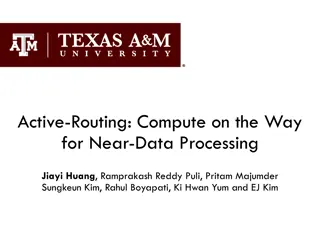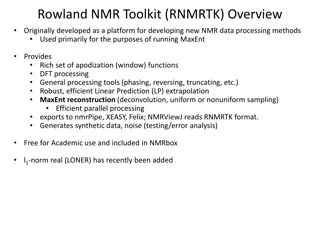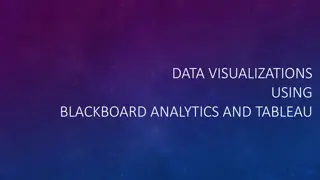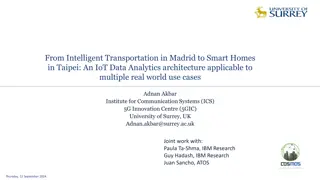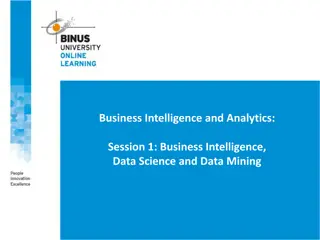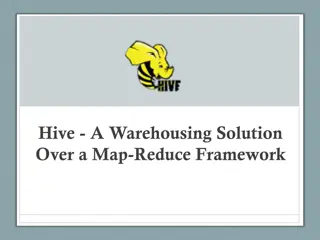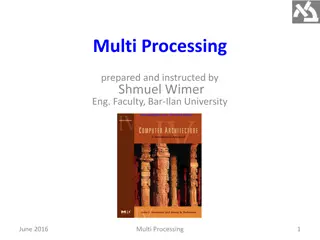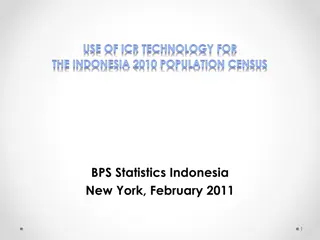Understanding Data Warehousing and Online Analytical Processing (OLAP)
Exploring the concepts of data warehousing and OLAP, this content covers topics such as OLTP, OLAP processing styles, and the role of OLAP in dynamic enterprise analysis. It also delves into the critical explanations and scenarios of online analytical processing, providing insights into how to achieve desired outcomes through varying parameters and the rules for effective OLAP implementation.
Download Presentation

Please find below an Image/Link to download the presentation.
The content on the website is provided AS IS for your information and personal use only. It may not be sold, licensed, or shared on other websites without obtaining consent from the author. Download presentation by click this link. If you encounter any issues during the download, it is possible that the publisher has removed the file from their server.
E N D
Presentation Transcript
Data Warehousing COMP3017 Advanced Databases Dr Nicholas Gibbins nmg@ecs.soton.ac.uk 2013-2014
Processing Styles OLTP On-Line Transaction Processing Traditional workloads, bread and butter processing Volumes of data, transactions grow, networks getting larger. 2
Processing Styles OLAP On-Line Analytical Processing includes the use of data warehouses multidimensional databases data analysis 3
Online Analytical Processing OLAP is the name given to the dynamic enterprise analysis required to create, manipulate, animate and synthesise information from exegetical, contemplative and formulaic data analysis models 4
Online Analytical Processing OLAP is the name given to the dynamic enterprise analysis required to create, manipulate, animate and synthesise information from exegetical, contemplative and formulaic data analysis models Exegesis: critical explanation How did we get to where we are? 5
Online Analytical Processing OLAP is the name given to the dynamic enterprise analysis required to create, manipulate, animate and synthesise information from exegetical, contemplative and formulaic data analysis models Asking what if? questions How does the outcome change if we vary the parameters? 6
Online Analytical Processing OLAP is the name given to the dynamic enterprise analysis required to create, manipulate, animate and synthesise information from exegetical, contemplative and formulaic data analysis models Which parameters must be varied in order to achieve a given outcome? 7
12 Rules for OLAP 1. Multidimensional conceptual view 7. Dynamic sparse matrix handling 2. Transparency 8. Multi-user support 3. Accessibility 9. Unrestricted cross-dimensional operations 4. Consistent reporting performance 10. Intuitive data manipulation 5. Client-server architecture 11. Flexible reporting 6. Generic dimensionality 12. Unlimited dimensions and aggregation levels 8
Data Mining Data mining is the process of discovering hidden patterns and relations in large databases using a variety of advanced analytical techniques Data mining attempts to use the computer to discover relationships that can be used to make predictions Data mining tools often find unsuspected relationships in data that other techniques will overlook 9
Data Mining Approaches Rule-based analysis Neural networks Fuzzy Logic K-nearest-neighbour Genetic algorithms Advanced visualisation Combination of any of the above 10
The Data Warehouse A data warehouse is a subject-oriented, integrated, time-variant, non-volatile collection of data that is used primarily in organisational decision making 11
The Data Warehouse A data warehouse is a subject-oriented, integrated, time-variant, non-volatile collection of data that is used primarily in organisational decision making The data is organised according to subject instead of application and contains only the information necessary for decision support processing. 12
The Data Warehouse A data warehouse is a subject-oriented, integrated, time-variant, non-volatile collection of data that is used primarily in organisational decision making Data encoding is made uniform (e.g. sex = f or m, 1 or 2, b or g - needs to be all the same in the warehouse). Data naming is made consistent. 13
The Data Warehouse A data warehouse is a subject-oriented, integrated, time-variant, non-volatile collection of data that is used primarily in organisational decision making Data is collected over time and can then be used for comparisons, trends and forecasting 14
The Data Warehouse A data warehouse is a subject-oriented, integrated, time-variant, non-volatile collection of data that is used primarily in organisational decision making The data is not updated or changed once in the data warehouse, but is simply loaded, and then accessed. The data warehouse is held quite separately from the operational database, which supports OLTP. 15
Why a Separate Data Warehouse? Performance Operational databases are optimised to support known transactions and workloads Special data organisation, access methods and implementation methods are needed Complex OLAP queries would degrade performance for operational transactions 16
Why a Separate Data Warehouse? Missing data Decision support requires historical data, which operational databases do not typically maintain Data consolidation Decision support requires consolidation (aggregation, summarisation) of data from many heterogeneous sources, including operational databases and external sources Data quality Different sources typically use inconsistent data representations, codes and formats, which have to be reconciled 17
Extracting Data OPERATIONAL DATA WAREHOUSE Risk replace change Car Liability insert change Policy replace insert Claim Customers EIS DSS Analysis Etc - Data is cleansed - Data is restructured 18
The Data Warehouse A Data Warehouse may be realised: via a front end to existing databases and files in a fresh relational database in a multidimensional database (MDDB) in a proprietary database format using a mixture of the above 19
The Data Warehouse Data may be accessed in various ways: Decision Support Systems (DSS) Executive Information Systems (EIS) Data Mining On-Line Analytical Processing 20
Data Marts A data mart focuses on only one subject area, or only one group of users An organisation can have one enterprise data warehouse many data marts Data marts do not contain operational data Data marts are more easily understood and navigated 21
Multidimensional Analysis Need to examine data in various ways Produce views of multidimensional data for users: Slice Dice Pivot Drill down Roll up 22
Multidimensional Analysis Slice Operator Train Performance - 3 dimensions - Operators - Performance - Time One operator's performance over time Time Performance Overall performance for one criterion over time Overall performance on a particular day 23
Multidimensional Analysis Dice W S N 10 Juice Cola Milk Cream Toothpaste Soap Product 50 20 12 15 10 1 2 3 4 5 6 Month 24
Multidimensional Analysis Pivot W S N Juice 10 50 Cola Product Milk 20 Cream 12 Toothpaste 15 Soap 10 1 2 3 4 5 6 Month Region Product 25
Multidimensional Analysis Drill Down W S N Juice 10 50 Cola by brand Product Milk 20 Cream 12 Toothpaste 15 Soap 10 1 2 3 4 5 6 Month 26
Multidimensional Analysis Roll Up W S N 80 Beverages Product Toiletries 37 1 2 3 4 5 6 Month 27
Internal Aspects Schemas Star schema Snowflake schema Fact constellation schema Aggregated data Specialised indexes Bit map indexes (see lecture on multidimensional indexes) Join indexes Specialised join methods 28
Star Schema Time Geography Code Region Code Region Manager City Code City Name Post Code Time Code Quarter Code Quarter Name Date Month Code Month Name Day Code Day of Week Season Sales Geography Code Time Code Account Code Product Code Sterling Amount Units Product Product Code Product Name Brand Manager Brand Name Prod Line Code Prod Line Name Prod Line Mgr Product Name Product Colour Product Model No Account Account Code Key Account Code Key Account Name Account Name Account Type Account Market 29
Fact Tables Prod_Code Time_Code Acct_Code Sales Qty 101 2045 501 100 1 102 2045 501 225 2 103 2046 501 200 20 104 2046 502 250 25 105 2046 502 20 1 numerical measures key columns joining fact table to the dimension tables 30
Part of a Snowflake Schema Brand Product Line Product Desc Brand Code Brand Manager Brand Name Prod Line Code Prod Line Name Prod Line Mgr Product Name Product Colour Product Model No Quarter Product Quarter Code Quarter Name Product Code Prod Line Code Brand Code Month Time Sales Month Code Month Name Time Code Year Code Quarter Code Month Code Day Code Geography Code Time Code Account Code Product Code Sterling Amount Units Day Day Code Day of Week Season 31
Data Warehouse Databases Relational and Specialised RDBMSs Specialised indexing techniques, join and scan methods Relational OLAP (ROLAP) servers Explicitly developed to use a relational engine to support OLAP Include aggregation navigation logic, the ability to generate multi- statement SQL, and other additional services Multidimensional OLAP (MOLAP) servers The storage model is an n-dimensional array May use a 2-level approach, with 2-D dense arrays indexed by B-Trees Time is often one of the dimensions 32
